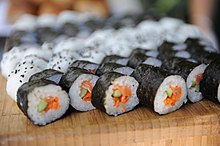Pyropia
| Pyropia | ||||||||||||
|---|---|---|---|---|---|---|---|---|---|---|---|---|

Pyropia thuretii |
||||||||||||
| Systematics | ||||||||||||
|
||||||||||||
| Scientific name | ||||||||||||
| Pyropia | ||||||||||||
| J. Agardh |
Pyropia is a genus of red algae from the order of the Bangiales . After molecular genetic studies, it was separated from the genus of the purple tangerine ( Porphyra ) in2011. The approximately 70 species are distributed worldwide on the sea coasts. They are widely used as food andcultivatedto make nori .
description
The gametophyte of Pyropia grows as a single-layer leaf-like thallus that is pink, red, purple, green or brown in color. It reaches a length of a few centimeters to several meters. The shape is linear, egg-shaped, rounded or funnel-shaped, the edge can be smooth or toothed, flat, wavy or curled.
The vegetative cells usually have a single plastid (in a few species, two).
The haploid chromosome number of the species examined so far is 2–4. Representatives of the genus can only be reliably distinguished from other leaf-shaped Bangiales by molecular genetic sequence differences.
Reproduction
The male and female gametes are formed either on the same or on different thalli ( monocyte or diocyte ). Monocial thalli either have male and female sectors separated by a line, or the spermatangia and zygotosporangia are either arranged as groups of cells in stripes or rectangular to diamond-shaped spots, or they lie in mixed fertile regions. In the case of the diocese thalli and the monocial with sectors, they form contiguous areas at the edge of the thallus.
Some basal species also reproduce through asexual spores.
The two-part life cycle typical of Pyropia is described in Pyropia gardneri .
Occurrence
Pyropia is widespread on all sea coasts, the species come from tropical to cold-tempered regions. They can be found from the upper tidal zone to the sublittoral and grow on rocks or perched on other algae or animals such as mussels. Some species are short-lived while others can survive for several years.
Systematics


The first scientific description of Pyropia was in 1899 by Jacob Georg Agardh . The type species Pyropia californica is now part of Pyropia nereocystis . The genus has long been considered a synonym for Porphyra (purple orange). This species-rich genus turned out to be polyphyletic in molecular biological studies . Therefore, numerous previous Porphyra species were outsourced to Pyropia in 2011 .
According to AlgaeBase, the genus Pyropia comprises around 70 species (August 2018).
- Pyropia abbottiae
- Pyropia acanthophora
- Pyropia aeodis
- Pyropia bajacaliforniensis
- Pyropia brumalis
- Pyropia cinnamomea
- Pyropia collinsii
- Pyropia columbiensis
- Pyropia columbina
- Pyropia conwayae
- Pyropia crassa
- Pyropia dentata
- Pyropia denticulata
- Pyropia drachii
- Pyropia elongata
- Pyropia endiviifolia
- Pyropia fallax
- Pyropia francisii
- Pyropia fucicola
- Pyropia gardneri
- Pyropia haitanensis
- Pyropia hiberna
- Pyropia hollenbergii
- Pyropia ishigecola
- Pyropia kanakaensis
- Pyropia katadae
- Pyropia kinositae
- Pyropia koreana
- Pyropia kuniedae
- Pyropia kurogii
- Pyropia lacerata
- Pyropia lanceolata
- Pyropia leucosticta
- Pyropia montereyensis
- Pyropia moriensis
- Pyropia nereocystis
- Pyropia nitida
- Pyropia njordii
- Pyropia novae-angliae
- Pyropia olivii
- Pyropia onoi
- Pyropia orbicularis
- Pyropia parva
- Pyropia peggicovensis
- Pyropia pendula
- Pyropia perforata
- Pyropia plicata : in New Zealand, formerly erroneously referred to as Pyropia columbina .
- Pyropia protolanceolata
- Pyropia pseudolanceolata
- Pyropia pseudolinearis
- Pyropia pulchella
- Pyropia pulchra
- Pyropia rakiura
- Pyropia raulaguilarii
- Pyropia retorta
- Pyropia saldanhae
- Pyropia seriata
- Pyropia spathulata
- Pyropia spiralis
- Pyropia stamfordensis
- Pyropia suborbiculata
- Pyropia taeniata
- Pyropia tanegashimensis
- Pyropia tenera
- Pyropia tenuipedalis
- Pyropia thulaea
- Pyropia thuretii
- Pyropia torta
- Pyropia unabbottiae
- Pyropia vietnamensis
- Pyropia virididentata
- Pyropia yezoensis
use
Numerous types of pyropia are used as food . A mixture of several Pyropia and Porphyra species is usually harvested on the coasts . In Japan they are known as “ nori ”, where Pyropia yezoensis and Pyropia tenera in particular are cultivated industrially on a large scale. In China “Zicai” and “Haidai ” are consumed , in Korea “ Gim / Kim ”. Pyropia columbina is called "Luche" in Chile and Pyropia plicata is called "Karengo" in New Zealand.
Individual evidence
- ↑ a b c d e f g Judith E. Sutherland et al .: A new look at an ancient order: generic revision of the Bangiales (Rhodophyta) . Journal of Phycology 47 (5), 2011, pp. 1131-1151. doi : 10.1111 / j.1529-8817.2011.01052.x
- ^ Jacob Georg Agardh: Analecta algologica, Continuatio V. Lunds Universitets Års-Skrift, Andra Afdelningen, Kongl. Fysiografiska Sällskapets i Lund Handlingar 35 (4): 1–160. 1899, p. 149
- ↑ a b Michael D. Guiry in Michael D. Guiry, GM Guiry: Pyropia - In: Algaebase - World-wide electronic publication, National University of Ireland, Galway, accessed August 22, 2018.
- ↑ Michael Guiry: Nori Cultivation , The Seaweed Site: information on marine algae, accessed August 22, 2018.



